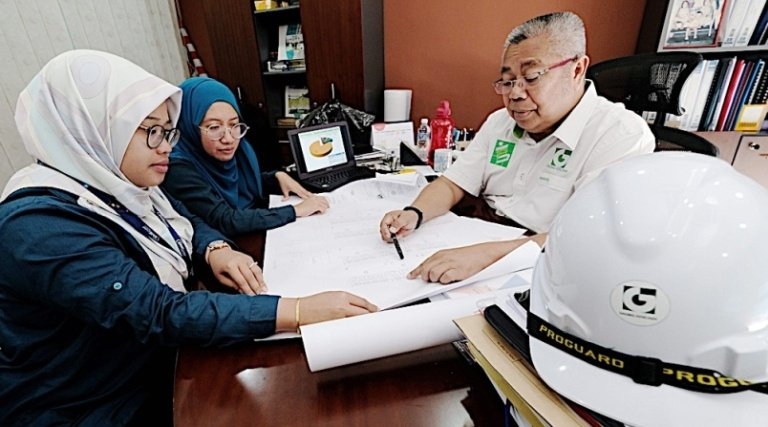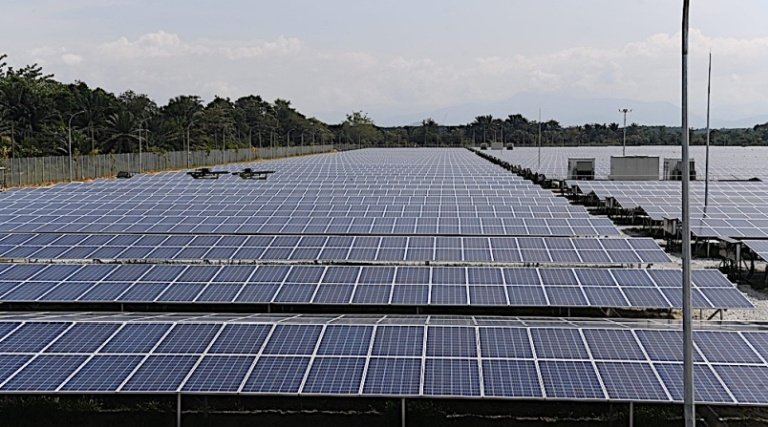The 30-megawatt (MW) Large-scale Solar Photovoltaic (LSSPV) solar farm project in Bidor, Perak has transformed the landscape of the town which was previously a tin mining area.
The 50-hectare solar power plant operating in Kampung Pasir, Jalan Teluk Intan, Bidor since October last year was undertaken by Gading Kencana Development Sdn. Bhd. (GKDSB).

GKDSB is a wholly-owned Bumiputera company and has more than two decades of experience in the solar energy industry in the country.
LSSPV is the company’s largest project besides having another solar farm in Ayer Keroh, Melaka with a total area of seven hectares.
The project in Ayer Keroh is the world’s most efficient plant capable of producing 1MW in every 0.61 hectares compared to 1MW world standards in every 2.02 hectares.
Detailing more about the solar energy company, Managing Director of GKDSB, Datuk Ir. Guntor Tobeng said the company’s first solar plant project was in Ayer Keroh in 2014 with investments of RM84 million that could generate 10 million kilowatt hours (kWh) per year.

“The experience (GKDSB) of developing a solar plant project in Ayer Keroh has enabled the company to succeed in LSSPV bid in Bidor, Perak.
“We are the only individual Bumiputera company selected in the bid list,” he said when met by K2 at Wisma Gading, Section 13, Shah Alam, Selangor recently.
In light of that, the LSSPV will produce 53,651,000 kilowatt hours (kWh) per year and save 800,000 tonnes of carbon emissions.
Savings
The farm uses 110,500 pieces of solar-made Malaysia modules and creates around 304 jobs for local folks.

“The solar plant capacity of 30MW per year will save 800,000 tons of carbon emissions.
“Hence, the construction is in line with the national aspiration to achieve the 2080 renewable energy (RE) target of 2,080MW under the Renewable Energy Policy and Action Plan,” said the Kedah-born who hails from Alor Setar.
Recalling the early establishment of GKDSB, he used his savings and his wifes’, Datin Hasnah Awang of RM2,000 to set up the company in 1998.
“At that time Malaysia experienced an economic crisis, it was difficult for us to get a bank loan.
“I also sold a home for RM280,000 and used a credit card amounting to RM50,000 to expand the business,” said the eldest of the five siblings.
He added that he used 10 years of experience as a marketing manager in an electronics company to run a solar business.
He chose a solar business because he wanted to find a difference as it was new and many did not know about it.
The first product sold by the company are solar garden lamps but a year later it faced fierce competition from the China market which offered lower prices.
New products
Not wanting to give up, Guntor has taken the next step by introducing new products namely solar street lamps and solar hybrid in rural schools.
“Around 2011 the government opened Feed-in Tariff, a policy mechanism designed to accelerate investment in renewable energy.
“I’m grateful for the application and start the first solar plant project in Melaka,” said the father of three children.
The success of the project in Melaka opens a new chapter for GKDSB when it was granted a license to establish a large-scale solar plant at Bidor.
Guntor said Bidor was selected for the large-scale project because of its better lighting as well as wind ventilation that helped generate more solar energy.
The plant also has a history of engineering in the country because, for the first time, it has been successfully connecting electricity to the 132KV national grid.
GKDSB solar energy is sold to Tenaga Nasional Bhd., (TNB), a corporation and also exported to Saudi Arabia and Cambodia.
He is grateful for the support of government agencies such as
Unit Peraju Agenda Bumiputera, Credit Guarantee Corporation Malaysia Bhd., SME Corp., Majlis Amanah Rakyat (Mara) which assisted the company in the solar plant project.
In view of this, it is not surprising that GKDSB received several awards such as the ASEAN Energy Awards for the second time in 2018 and the Mara Entrepreneurs Award in 2017.

Meanwhile, LSSPV Manager at Bidor, Nurul Hidayah Mohamad Sahudi , 27, said that 15 personnel were stationed in the field, divided into two units, namely the maintenance of solar farms and electrical systems.
Patrolling
“We will be patrolling two days in the field to ensure no damages and all systems are running smoothly.
“The land in the Bidor area is very fertile and the weeds grow fast so we will keep the grass clean and cut it off as it will disrupt the system and the absorption of solar energy,” he explained.
He said the solar panels are durable and do not need to be changed frequently.
Similarly, the cleaning of the panel will be made according to its condition if there is a bird’s stool or dust.
Nurul Hidayah said that the rain had disturbed some of the operations on the farm as it could only generate about 120,000 to 130,000 kWh a day compared to the usual day of around 160,000 kWh.
Solar energy generation is very critical during haze and solar eclipses.
Meanwhile, solar plant supervisors in Ayer Keroh, Melaka, Mohd. Zaid Abd. Aziz , 32, shared his experience of the haze around 2016.
“At that time solar generation has dropped by 20 to 25 percent and lasted for a week.
“We can not do anything and just wait for the haze to recover,” the father of three children stated.
Commenting on the operation of the field, Mohd. Zaid said he was assisted by four staff comprising engineers, general workers and technicians.
“At this farm, there are 29,092 solar panels installed and we are responsible for ensuring that the system works well as well as the surrounding environment.
“If it is in dusty industrial areas then the cleaning of the panels needs to be done more often but the plants in Ayer Keroh are far from the industrial estate,” .
All of the solar panels generated by the panel will be channeled directly to the nearest TNB substation.
Gading Kencana Development Sdn. Bhd. build solar fields in Bidor, Perak and Ayer Keroh, Melaka which can generate almost 54 million kilowatt hours a year.
Interested in doing your own solar project too? Click here to find out more!
Credits: Utusan
